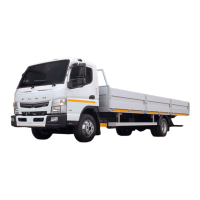
Do you have a question about the Mitsubishi 2013 Outlander and is the answer not in the manual?
| Brand | Mitsubishi |
|---|---|
| Model | 2013 Outlander |
| Category | Automobile |
| Language | English |
Highlights important safety messages and warnings in the manual.
Provides an overview and page references for front and rear seat adjustments.
Provides guidance on safe seat belt usage for pregnant women and unborn children.
Explains the SRS system, including airbags, knee airbags, side airbags, and curtain airbags.
Offers advice for the first 300 miles (500 km) to ensure future performance and economy.
Describes the provided keys, including the electronic immobilizer key and key number plate.
Explains the electronic immobilizer's function in preventing vehicle theft and its programming.
Explains how to lock and unlock doors and the liftgate using the keyless entry system.
Explains the F.A.S.T.-key system, its operation, and warnings for pacemaker users.
Details the operation modes (OFF, ACC, ON, START) of the engine switch and related cautions.
Explains the available drive modes (2WD, 4WD AUTO, 4WD LOCK) for the 4WD system.
Explains the cruise control system, its activation speeds, and driving condition cautions.
Explains the multi-information display's functions, including warnings, odometer, and fuel consumption.
Details the Bluetooth® 2.0 interface for hands-free calls, music playback, and voice commands.
Warns about utility vehicle rollover rates and emphasizes safe driving practices.
Offers advice on defensive driving, lane changes, and obeying traffic laws.
Lists recommended tire inflation pressures for normal driving conditions and cautions about pressure changes.
Warns about loading cargo, securing it, and potential risks from obstructed views or shifting items.
Provides initial steps to take when the vehicle breaks down, including hazard lights and engine issues.
Details the procedure for jump-starting a vehicle with a weak or dead battery using jumper cables.
Explains engine overheating warnings, how to stop the vehicle safely, and what to do if steam is present.
Outlines preparation steps before changing a tire, including vehicle positioning and safety warnings.
Details towing procedures for various vehicle configurations and warnings related to ASC operation.
Provides essential safety precautions and warnings for performing vehicle maintenance.
Explains how to check and refill engine oil, with cautions about overfilling and used oil.
Lists recommended tire maintenance steps, including pressure checks, alignment, and rotation.
Provides step-by-step instructions for replacing a fuse, including fuse remover usage.
Provides instructions and warnings for replacing halogen and HID bulbs, emphasizing safety.
Provides an overview of air vents and their adjustments.
Identifies controls on the manual air conditioning panel, including temperature, air selection, and blower speed dials.
Details the operation of automatic air conditioning systems.
Describes how to use the air selection switch for outside air or recirculated air, with notes and cautions.
Provides information on operating the audio system, including MMCS and external audio input.
Details the Bluetooth® 2.0 interface for hands-free calls, music playback, and voice commands.
Explains how to connect and play music files from a USB memory device.
Provides information on reporting safety defects to NHTSA and Mitsubishi Motors North America.
Details how to report safety defects to NHTSA (USA) and Transport Canada (Canada).
Emphasizes the importance of using genuine Mitsubishi Motors parts for vehicle integrity and protection.
Explains the importance of vehicle labeling for identification and police assistance.
Details vehicle weight ratings, including GVWR, GAWR, capacity weight, roof load, and seating capacity.
Provides detailed engine specifications like model, displacement, bore, stroke, and compression ratio.
Lists capacities and recommended lubricants for various vehicle fluids like fuel, engine oil, and coolant.












